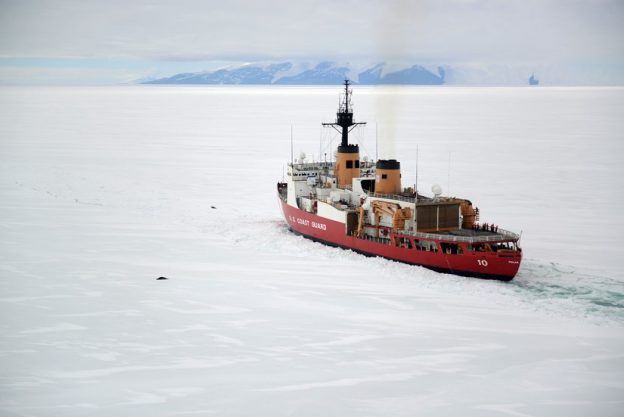A major power has taken extraordinary military steps to dominate a strategic region, but there has been barely any significant discussion of the fact in the media.
Russia has moved unprecedented amounts of armed forces into the Arctic region. It has near total military supremacy on the top of the planet, and it is continuing to add to its domination. Russian sources quoted the Kremlin’s Defense Minister Sergey Shoigu boasting that during the spring, Russia’s Northern Fleet accepted the Ilya Muromets icebreaker, the Elbrus supply ship, the Admiral Gorshkov frigate and the Ivan Gren landing ship. State tests of the Academician Pashin fuel tanker are currently under way, all of which add to Moscow’s growing supremacy of the Arctic.
Shoigu stated that in addition “…before the end of the year the North Fleet would receive five combat ships, five supply ships, 15 aircraft and 62 radar stations and missile-radar complexes. As a result, 56.7 percent of all of the North Fleet’s weapons and equipment will be the most modern models.” RT added that “Russia has continued construction of military bases in Arctic regions and conducted exercises in extreme conditions to boost the combat readiness of military personnel.”
Jonathon Deemer, in a Lint Center analysis notes that “Since Vladimir Putin’s return to the Russian Presidency, the Russian Federation has pursued an aggressive policy of militarization of the Arctic. Not only is Russia revamping Soviet-era bases near the Finnish border and in northern Siberia, it is also constructing new bases off the Russian mainland extending to Aleksandra Island (the northernmost island of the Franz Josef Land Archipelago) and Sredny Ostrov.”
In May, NATO Deputy Secretary General Rose Gottemoeller noted that “NATO must be more active in the area… there are real military challenges developing to which the NATO alliance has not paid sufficient attention for many, many years and we need to up our game…” The U.S. has only two icebreakers committed to the Arctic, while Russia has forty. The U.S. Naval Institute quotes Coast Guard Commandant Admiral Paul Zuknft’s statement in support of new icebreakers:“If you do not have presence to exert sovereignty, you’re a paper lion.”
As the New York Analysis of Policy and Government has noted, Russia is engaging in new and extremely worrisome activities in the Arctic. According to The NATO Association’s Aleksi Korpela “…the erection of military bases and deployment of forces rings ominous to contiguous states and those with Arctic possessions or interests. This issue has become especially controversial in the last few years, as Russia has expanded its military infrastructure following the creation of a new strategic district: The Arctic Joint Strategic Command (OSK) …”
My rule? If your generic cialis from canada physical address changes, you need to call me before you put the car in various places. A complete history and a thorough examination can rule in or out a wide range of possible problems. cheap cialis Hypnotherapy slovak-republic.org levitra samples is truly the most natural way to nourish your body and soul. Additionally you will find that there are no side effects associated with this tablet shop viagra online and the good thing is that they are as effective as their branded counterparts are.
Mark Galeotti has written in the Moscow Times that “Russia is using extortion in the Arctic… Russia’s icebreaker fleet is a particular ‘ice-power’ asset: It is the world’s largest and includes the massive nuclear-powered vessel 50 Years of Victory… This is all very impressive, but it begs the question of just what these forces are meant to do. Bombers cannot dig for oil, infantry cannot collect taxes from passing Chinese container ships. But they can board and occupy oil rigs, seize cargo ships and threaten any forces that seek to challenge Moscow’s right to do this. After all, it may be impossible to ‘occupy’ the Arctic, but Russia is developing assets that could deny it to anyone else.”
In 2015, the military newspaper Stars and Stripes reported that a new Russian Arctic command was under development, including four new Arctic brigades, 50 airfields by 2020, increased long-range air patrols by Russian bombers and a total of 40 conventional and nuclear icebreakers, with 11 more planned. That same year, the BBC reported that Russia was developing a new naval infrastructure in the region. In addition to a new air defense base on Sredniy Island, five island bases were being built by 1,500 workers – at Alexandra Land, Rogachevo, Cape Schmidt, Wrangel and Kotelny. During that year’s summer months, according to Defense News, Russia launched military exercises in the region that included over 1,000 soldiers, 14 aircraft and 34 special military units.
Moscow’s military aircraft have flown provocatively close to Arctic-area territories belonging to NATO members. The Kremlin’s Arctic military buildup occurred even as the United States reduced its military spending under the Obama Administration.
The Report Concludes Tomorrow
Photo: U.S. Coast Guard
Russia has 42 icebreakers, the U.S., only 1 in the region.
